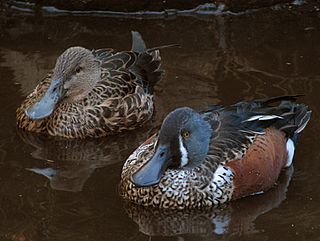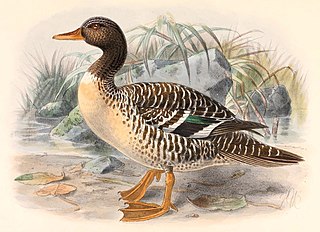
Anseriformes is an order of birds also known as waterfowl that comprises about 180 living species of birds in three families: Anhimidae, Anseranatidae, and Anatidae, the largest family, which includes over 170 species of waterfowl, among them the ducks, geese, and swans. Most modern species in the order are highly adapted for an aquatic existence at the water surface. With the exception of screamers, males have penises, a trait that has been lost in the Neoaves. Due to their aquatic nature, most species are web-footed.

The stiff-tailed ducks, Oxyura, are part of the Oxyurini tribe of ducks. The genus name is derived from Ancient Greek oxus, "sharp", and oura, "tail".

Biziura is a genus of stiff-tailed ducks endemic to Australasia and containing one living and one subfossil species.

Anas is a genus of dabbling ducks. It includes the pintails, most teals, and the mallard and its close relatives. It formerly included additional species but following the publication of a molecular phylogenetic study in 2009 the genus was split into four separate genera. The genus now contains 31 living species. The name Anas is the Latin for "duck".

Aythya is a genus of diving ducks. It has twelve described species. The name Aythya comes from the Ancient Greek word αυθυια, which may have referred to a sea-dwelling duck or an auklet.

The Australian wood duck, maned duck or maned goose is a dabbling duck found throughout much of Australia. It is the only living species in the genus Chenonetta. Traditionally placed in the subfamily Anatinae, it might belong to the subfamily Tadorninae (shelducks); the ringed teal may be its closest living relative.

The Australasian shoveler is a species of dabbling duck in the genus Spatula. It ranges from 46 to 53 cm. It lives in heavily vegetated swamps. In Australia it is protected under the National Parks and Wildlife Act, 1974. They occur in southwestern and southeastern Australia, Tasmania, and New Zealand. The male has a blue-grey head with a vertical white crescent in front of the eyes. The status of the Australasian shoveler is near threatened.

Salvadori's teal or Salvadori's duck, is a species of bird endemic to New Guinea. It is placed in the monotypic genus Salvadorina.
The Ilariidae is a family of fossil mammals. Most ilariids are found in the middle Tertiary faunal assemblages of South Australia. Ilaria illumidens is the best-preserved representative of this extinct clade of vombatiforms.

Palaelodus is an extinct genus of birds distantly related to flamingos. They were slender birds with long, thin legs and a long neck. Little is known about the shape of their skull or beak. Some paleontologists think Palaelodus was able to swim under water, chasing prey, but the morphology of their feet seems not very well adapted for diving. Rather, it is more likely that they were adapted to browsing for food while swimming or standing in shallow water.

Finsch's duck was a large terrestrial species of duck formerly endemic to New Zealand. The species was possibly once the most common duck in New Zealand, a supposition based on the frequency of its fossils in bone deposits. The species was originally considered to be in its own genus, Euryanas, but is now known to be closely related to the maned duck and recently derived from that species.
The New Zealand stiff-tailed duck is an extinct duck species from New Zealand which is known only from subfossil remains. It was first described as a distinct species by Trevor H. Worthy in 2005.
Scarlett's duck is an extinct duck species from New Zealand which was closely related to the Australian pink-eared duck. The scientific name commemorates the late New Zealand ornithologist and palaeontologist Ron Scarlett who discovered the holotype in 1941. However, previously undescribed bones of the species found in 1903 were rediscovered in the Otago Museum in 1998. At least 32 fossil remains from deposits in Pyramid Valley, at Ngapara in the South Island, and at Lake Poukawa in the North Island are in museum collections.
The New Zealand musk duck, also known as de Lautour's duck, is an extinct stiff-tailed duck native to New Zealand. It is only known from subfossil bones. Its closest relative was the living Australian musk duck Biziura lobata, with which it has sometimes been combined.
Nambashag is an extinct genus of early cormorant from Late Oligocene and Early Miocene deposits of South Australia. The genus was first named by Trevor H. Worthy in 2011 and the type species is Nambashag billerooensis. A second species, N. microglaucus, was also named. The type species is known from 30 specimens while N. microglaucus is known from 14 specimens. The specimens of Nambashag were collected from the Etadunna and Namba Formations in the Lake Eyre and Lake Frome Basins.
Australotadorna alecwilsoni is an extinct genus and species of bird, in the shelduck subfamily of the duck family, from the Late Oligocene of central Australia. The genus name comes from the Latin australis and Tadorna. The specific epithet honours Alec Wilson, pastoral lease holder of Frome Downs Station, who supported palaeontological access to, and investigation of, fossil sites on his property. The type locality is Lake Pinpa in the Lake Eyre Basin of north-eastern South Australia.
Wilaru is an extinct genus of bird of uncertain phylogenetic placement from the Late Oligocene to Early Miocene of Australia. It was originally classified as a stone-curlew, but subsequently it was argued to be a member of the extinct family Presbyornithidae instead. It is either the oldest known burhinid or the youngest known presbyornithid. The type species is Wilaru tedfordi; genus also includes the second species Wilaru prideauxi. The type species was described from fossil material collected from Lake Pinpa, Lake Palankarinna and Billeroo Creek, in the Lake Eyre Basin of north-eastern South Australia. The genus name Wilaru is the term for “stone curlew” in the Diyari language of the Lake Eyre region. The specific epithet of the type species honours American palaeontologist Richard H. Tedford (1929–2011) of the American Museum of Natural History, who led the 1971 expedition to Lake Pinpa during which much of the descriptive material was collected.

The St Bathans fauna is found in the lower Bannockburn Formation of the Manuherikia Group of Central Otago, in the South Island of New Zealand. It comprises a suite of fossilised prehistoric animals from the late Early Miocene (Altonian) period, with an age range of 19–16 million years ago.
Manuherikia is a genus of extinct species of ducks from the Miocene of New Zealand. It was described from fossil material of the Saint Bathans Fauna, in the lower Bannockburn Formation of the Manuherikia Group, found by the Manuherikia River in the Central Otago region of the South Island. The genus name comes from the name of the geological formation in which the fossils were found and, ultimately, from the Manuherikia River and its valley.













